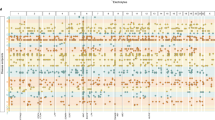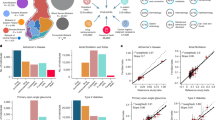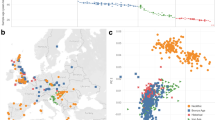Abstract
Analyzing genetic variation of human populations for detecting loci that have been affected by positive natural selection is important for understanding adaptive history and phenotypic variation in humans. In this study, we analyzed recent positive selection in Northern Europe from genome-wide data sets of 250 000 and 500 000 single-nucleotide polymorphisms (SNPs) in a total of 999 individuals from Great Britain, Northern Germany, Eastern and Western Finland, and Sweden. Coalescent simulations were used for demonstrating that the integrated haplotype score (iHS) and long-range haplotype (LRH) statistics have sufficient power in genome-wide data sets of different sample sizes and SNP densities. Furthermore, the behavior of the FST statistic in closely related populations was characterized by allele frequency simulations. In the analysis of the North European data set, 60 regions in the genome showed strong signs of recent positive selection. Out of these, 21 regions have not been discovered in previous scans, and many contain genes with interesting functions (eg, RAB38, INFG, NOS1AP, and APOE). In the putatively selected regions, we observed a statistically significant overrepresentation of genetic association with complex disease, which emphasizes the importance of the analysis of positive selection in understanding the evolution of human disease. Altogether, this study demonstrates the potential of genome-wide data sets to discover loci that lie behind evolutionary adaptation in different human populations.
Similar content being viewed by others
Log in or create a free account to read this content
Gain free access to this article, as well as selected content from this journal and more on nature.com
or
References
Blekhman R, Man O, Herrmann L et al: Natural selection on genes that underlie human disease susceptibility. Curr Biol 2008; 12: 883–889.
Bustamante CD, Fledel-Alon A, Williamson S et al: Natural selection on protein-coding genes in the human genome. Nature 2005; 7062: 1153–1157.
Carlson CS, Thomas DJ, Eberle MA et al: Genomic regions exhibiting positive selection identified from dense genotype data. Genome Res 2005; 11: 1553–1565.
Akey JM, Zhang G, Zhang K, Jin L, Shriver MD : Interrogating a high-density SNP map for signatures of natural selection. Genome Res 2002; 12: 1805–1814.
Oleksyk TK, Zhao K, De La Vega FM, Gilbert DA, O'Brien SJ, Smith MW : Identifying selected regions from heterozygosity and divergence using a light-coverage genomic dataset from two human populations. PLoS ONE 2008; 3: e1712.
O'Reilly PF, Birney E, Balding DJ : Confounding between recombination and selection, and the Ped/Pop method for detecting selection. Genome Res 2008; 8: 1304–1313.
Sabeti PC, Varilly P, Fry B et al: Genome-wide detection and characterization of positive selection in human populations. Nature 2007; 7164: 913–918.
Wang ET, Kodama G, Baldi P, Moyzis RK : Global landscape of recent inferred Darwinian selection for Homo sapiens. Proc Natl Acad Sci USA 2006; 1: 135–140.
Voight BF, Kudaravalli S, Wen X, Pritchard JK : A map of recent positive selection in the human genome. PLoS Biol 2006; 3: e72.
Tang K, Thornton KR, Stoneking M : A new approach for using genome scans to detect recent positive selection in the human genome. PLoS Biol 2007; 7: e171.
Williamson SH, Hubisz MJ, Clark AG, Payseur BA, Bustamante CD, Nielsen R : Localizing recent adaptive evolution in the human genome. PLoS Genet 2007; 6: e90.
International HapMap Consortium Frazer KA, Ballinger DG et al: A second generation human haplotype map of over 3.1 million SNPs. Nature 2007; 7164: 851–861.
Hinds DA, Stuve LL, Nilsen GB et al: Whole-genome patterns of common DNA variation in three human populations. Science 2005; 5712: 1072–1079.
Heath SC, Gut IG, Brennan P et al: Investigation of the fine structure of European populations with applications to disease association studies. Eur J Hum Genet 2008; 12: 1413–1429.
Jakobsson M, Scholz SW, Scheet P et al: Genotype, haplotype and copy-number variation in worldwide human populations. Nature 2008; 7181: 998–1003.
Li JZ, Absher DM, Tang H et al: Worldwide human relationships inferred from genome-wide patterns of variation. Science 2008; 5866: 1100–1104.
Novembre J, Johnson T, Bryc K et al: Genes mirror geography within Europe. Nature 2008; 7219: 274.
Salmela E, Lappalainen T, Fransson I et al: Genome-wide analysis of single nucleotide polymorphisms uncovers population structure in Northern Europe. PLoS ONE 2008; 10: e3519.
Kimura R, Ohashi J, Matsumura Y et al: Gene flow and natural selection in oceanic human populations inferred from genome-wide SNP typing. Mol Biol Evol 2008; 8: 1750–1761.
Pickrell JK, Coop G, Novembre J et al: Signals of recent positive selection in a worldwide sample of human populations. Genome Res 2009; 5: 826–837.
Krawczak M, Nikolaus S, von Eberstein H, Croucher PJ, El Mokhtari NE, Schreiber S : PopGen: population-based recruitment of patients and controls for the analysis of complex genotype-phenotype relationships. Community Genet 2006; 1: 55–61.
Wellcome Trust Case Control Consortium: Genome-wide association study of 14 000 cases of seven common diseases and 3000 shared controls. Nature 2007; 7145: 661–678.
International HapMap Consortium: A haplotype map of the human genome. Nature 2005; 7063: 1299–1320.
Sabeti PC, Reich DE, Higgins JM et al: Detecting recent positive selection in the human genome from haplotype structure. Nature 2002; 6909: 832–837.
Weir BS, Cockerham CC : Estimating F-statistics for the analysis of population structure. Evolution 1984; 38: 1358–1370.
Bandelt HJ, Forster P, Rohl A : Median-joining networks for inferring intraspecific phylogenies. Mol Biol Evol 1999; 1: 37–48.
Polzin T, Daneschmand SV : On Steiner trees and minimum spanning trees in hypergraphs. Operations Res Lett 2003; 31: 12–20.
Spencer CC, Coop G : SelSim: a program to simulate population genetic data with natural selection and recombination. Bioinformatics 2004; 18: 3673–3675.
Loftus SK, Larson DM, Baxter LL et al: Mutation of melanosome protein RAB38 in chocolate mice. Proc Natl Acad Sci USA 2002; 7: 4471–4476.
Oiso N, Riddle SR, Serikawa T, Kuramoto T, Spritz RA : The rat Ruby (R) locus is Rab38: identical mutations in Fawn-hooded and Tester-Moriyama rats derived from an ancestral Long Evans rat sub-strain. Mamm Genome 2004; 4: 307–314.
Osanai K, Oikawa R, Higuchi J et al: A mutation in Rab38 small GTPase causes abnormal lung surfactant homeostasis and aberrant alveolar structure in mice. Am J Pathol 2008; 5: 1265–1274.
Ben-Israel H, Sharf R, Rechavi G, Kleinberger T : Adenovirus E4orf4 protein downregulates MYC expression through interaction with the PP2A-B55 subunit. J Virol 2008; 19: 9381–9388.
Dagda RK, Merrill RA, Cribbs JT et al: The spinocerebellar ataxia 12 gene product and protein phosphatase 2A regulatory subunit Bbeta2 antagonizes neuronal survival by promoting mitochondrial fission. J Biol Chem 2008; 52: 36241–36248.
Stockman A, Smithson HE, Webster AR et al: The loss of the PDE6 deactivating enzyme, RGS9, results in precocious light adaptation at low light levels. J Vis 2008; 8: 10.1–10.10.
Hartong DT, Pott JW, Kooijman AC : Six patients with bradyopsia (slow vision): clinical features and course of the disease. Ophthalmology 2007; 12: 2323–2331.
Bersaglieri T, Sabeti PC, Patterson N et al: Genetic signatures of strong recent positive selection at the lactase gene. Am J Hum Genet 2004; 6: 1111–1120.
Thompson EE, Kuttab-Boulos H, Witonsky D, Yang L, Roe BA, Di Rienzo A : CYP3A variation and the evolution of salt-sensitivity variants. Am J Hum Genet 2004; 6: 1059–1069.
Lamason RL, Mohideen MA, Mest JR et al: SLC24A5, a putative cation exchanger, affects pigmentation in zebrafish and humans. Science 2005; 5755: 1782–1786.
Arking DE, Pfeufer A, Post W et al: A common genetic variant in the NOS1 regulator NOS1AP modulates cardiac repolarization. Nat Genet 2006; 6: 644–651.
Levy D, Larson MG, Benjamin EJ et al: Framingham Heart Study 100K Project: genome-wide associations for blood pressure and arterial stiffness. BMC Med Genet 2007; 8 (Suppl 1): S3.
Pacheco AG, Cardoso CC, Moraes MO : IFNG +874T/A, IL10 −1082G/A and TNF −308G/A polymorphisms in association with tuberculosis susceptibility: a meta-analysis study. Hum Genet 2008; 5: 477–484.
Silverberg MS, Cho JH, Rioux JD et al: Ulcerative colitis-risk loci on chromosomes 1p36 and 12q15 found by genome-wide association study. Nat Genet 2009; 2: 216–220.
Wratten NS, Memoli H, Huang Y et al: Identification of a schizophrenia-associated functional noncoding variant in NOS1AP. Am J Psychiatry 2009; 166: 434–441.
Coon KD, Myers AJ, Craig DW et al: A high-density whole-genome association study reveals that APOE is the major susceptibility gene for sporadic late-onset Alzheimer's disease. J Clin Psychiatry 2007; 4: 613–618.
Willer CJ, Sanna S, Jackson AU et al: Newly identified loci that influence lipid concentrations and risk of coronary artery disease. Nat Genet 2008; 2: 161–169.
Nielsen R, Hellmann I, Hubisz M, Bustamante C, Clark AG : Recent and ongoing selection in the human genome. Nat Rev Genet 2007; 11: 857–868.
Marchini J, Cardon LR, Phillips MS, Donnelly P : The effects of human population structure on large genetic association studies. Nat Genet 2004; 5: 512–517.
Lange EM, Sun J, Lange LA et al: Family-based samples can play an important role in genetic association studies. Cancer Epidemiol Biomarkers Prev 2008; 9: 2208–2214.
Freedman ML, Reich D, Penney KL et al: Assessing the impact of population stratification on genetic association studies. Nat Genet 2004; 4: 388–393.
Wong ML, Whelan F, Deloukas P et al: Phosphodiesterase genes are associated with susceptibility to major depression and antidepressant treatment response. Proc Natl Acad Sci USA 2006; 41: 15124–15129.
Teshima KM, Coop G, Przeworski M : How reliable are empirical genomic scans for selective sweeps? Genome Res 2006; 6: 702–712.
Hofer T, Ray N, Wegmann D, Excoffier L : Large allele frequency differences between human continental groups are more likely to have occurred by drift during range expansions than by selection. Ann Hum Genet 2009; 1: 95–108.
Huttley GA, Smith MW, Carrington M, O'Brien SJ : A scan for linkage disequilibrium across the human genome. Genetics 1999; 4: 1711–1722.
Nielsen R, Williamson S, Kim Y, Hubisz MJ, Clark AG, Bustamante C : Genomic scans for selective sweeps using SNP data. Genome Res 2005; 11: 1566–1575.
Acknowledgements
The funding for this study has been provided by the Emil Aaltonen foundation, the Research Foundation of the University of Helsinki, the Graduate School in Computational Biology, Bioinformatics, and Biometry, the Sigrid Juselius Foundation, the Academy of Finland, the Swedish Research Council, the Finnish Cultural Foundation, the National Genome Research Network (NGFN), and the PopGen Biobank, both through the German Ministry of Education and Science, and DFG excellence cluster ‘inflammation at interfaces’. Funding for the WTCCC project was provided by the Wellcome Trust under Award 076113. This study makes use of the data generated by the Wellcome Trust Case Control Consortium. A full list of the investigators who contributed to the generation of the data is available from www.wtccc.org.uk. Furthermore, we thank Ingegerd Fransson and the personnel at Bioinformatics and Expression analysis core facility at Karolinska Institutet for technical support.
Author information
Authors and Affiliations
Corresponding author
Ethics declarations
Competing interests
The authors declare no conflict of interest.
Additional information
Supplementary Information accompanies the paper on European Journal of Human Genetics website (http://www.nature.com/ejhg)
Supplementary information
Rights and permissions
About this article
Cite this article
Lappalainen, T., Salmela, E., Andersen, P. et al. Genomic landscape of positive natural selection in Northern European populations. Eur J Hum Genet 18, 471–478 (2010). https://doi.org/10.1038/ejhg.2009.184
Received:
Revised:
Accepted:
Published:
Issue date:
DOI: https://doi.org/10.1038/ejhg.2009.184
Keywords
This article is cited by
-
The adaptive evolution of cancer driver genes
BMC Genomics (2023)
-
Upregulation of cathepsin L gene under mild cold conditions in young Japanese male adults
Journal of Physiological Anthropology (2021)
-
Experimental evidence reveals the UCP1 genotype changes the oxygen consumption attributed to non-shivering thermogenesis in humans
Scientific Reports (2017)
-
Genetic regulatory effects modified by immune activation contribute to autoimmune disease associations
Nature Communications (2017)
-
Exploring the potential relevance of human-specific genes to complex disease
Human Genomics (2011)



